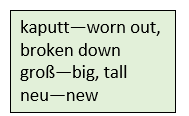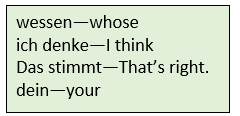2 Section 1-2
1-2: Definite Articles; Possession
Here are several objects that you might find in your classroom. Notice that they all begin with the definite article–der, die, or das. All of these mean the in English. Like many foreign languages, German nouns have a particular grammatical gender. It is best to learn new words together with the definite article.

Nouns in German are always capitalized! The definite article (der/die/das) is always lowercase unless it is at the beginning of a sentence. Always capitalize the first word of each sentence.
What’s a noun? A noun is a word that refers to a person, place, thing, or idea.






1 2 3 4 5 6



![]()



7 8 9 10 11 12






13 14 15 16 17






18 19 20 21 22


Ex. A: Was ist das? Ask each other about the items in your classroom. Don’t forget to include the definite article (der/die/das)!
A: Was ist das? (What is that?)
B: Das ist die Tasche.

Ex. B: Der, die oder das? List the definite article (der/die/das) for each classroom item listed below. If you can’t remember, look back at the pictures.
1. _______ Professorin 8. _________ Wand
2. ________Tafel 9. _________ Stuhl
3. ________ Fenster 10. _________ Tür
4. ________ Tasche 11. _________ Student
5. ________ Buch 12. ________ Kuli
6. ________ Wand 13. ________ Lehrer
7. _________ Stuhl 14. ________ Computer
EXTRA PRACTICE:
Click the link on Germanzone.org’s website to do more online practice with definite articles and classroom objects. The site will give you feedback on your mistakes.
Ex. C: Maskulin, weiblich oder Neutrum?
Video: How To Know a Word’s Gender: Super Easy German (70)
- a. _______% of all words are feminine.
b. _______% of all words are masculine.
c. _______% of all words are neuter.
2. Organize the following endings as masculine, feminine, or neuter.

|
Maskulin |
Feminin |
Neutrum |
|
|
|
|
3. Using what you learned, categorize the following nouns as masculine, feminine, or neuter.
1. _____ Endung
2. _____ Mädchen
3. _____ Häuslein
4. _____ Aktivität
5. _____ Testament
6. _____ Freundschaft
7. _____ Polizei
8. _____ Toleranz
9. _____ Rassismus
10. _____ Freiheit
11. _____ Universum
12. _____ Komma
13. _____ Migrant
14. _____ Student
15. _____ Teppich
16. _____ Musik
EXTRA PRACTICE:
Need more practice with predicting patterns of a word’s gender? Click the link to Germanzone.org’s online quiz that will give you feedback: https://www.germanzone.org/noun-genders-3/.
Possessive of proper names:
To show possession with proper names in German, add an -s to the end of the person’s name. If the name already ends in an -s or an “s” sound, such as -z or -ß, we add a comma to the end.
Ist das Melanies Buch?
Ritas Handy ist neu.
Reiners Computer ist kaputt.
Thomas‘ Rucksack ist zu groß.

Ex. D: Dialog: Read the following dialogue between two young children and answer the questions about it in complete sentences.

Heidi: Hallo, Walter!
Walter: Tag, Heidi.
Heidi: Wessen Kuli ist das?
Walter: Hmm. Ich denke, das ist Hans‘ Kuli.
Heidi: Ach, ja! Das stimmt! Und der Bleistift?
Walter: Das ist Inges Bleistift.
Heidi: Und der Filzstift? Wessen Filzstift ist das?
Walter: Aber Heidi! Das ist doch dein Filzstift!
- Wessen Kuli ist das?
- Wessen Bleistift ist das?
- Wessen Filzstift ist das?
Farben (colors)
Below are several colors that will help you describe objects with the definite articles you have already learned.

To express different shades of these, use dunkel– or hell– affixed to the color. Do not add a space between the words.

dunkel + rot = dunkelrot
hell + blau = hellblau
Beispiel:
- Der Bleistift ist gelb.
- Die Uhr ist schwarz und weiß.
- Das Heft ist dunkelgrau.
- Das Buch ist hellgrün.

Die deutsche Fahne ist schwarz, rot und gold.
Ex. E: Welche Farbe hat das? Ask each other about the colors of the items in your classroom.
![]()
A: Welche Farbe hat das Poster?
B: Das Poster ist hellblau, gelb und rosa.

Video. Need more examples? Watch Benjamin–der Deutschleher’s video to hear the colors pronounced with lots of examples:
EXTRA PRACTICE: Go to Germanzone.org’s website and do the online activities to describe the colors of each item you see. Although you may not recognize every word in the exercise, most of them are very much like English. When in doubt, use a dictionary to look it up.
Watch this Youtube video with examples of the colors rot and grün:

